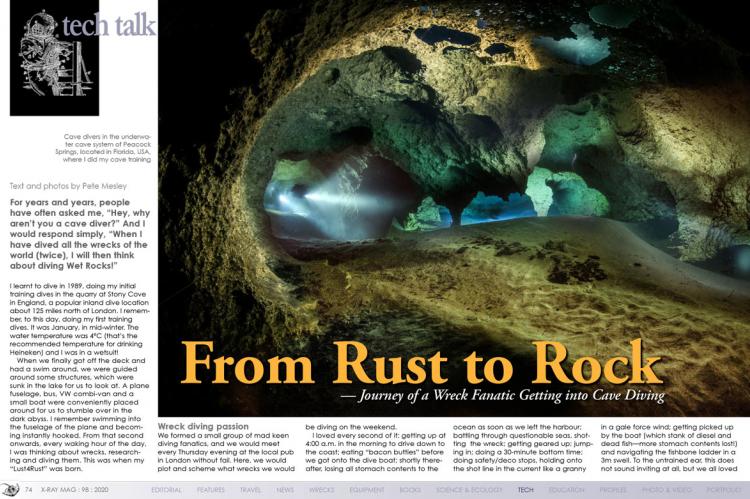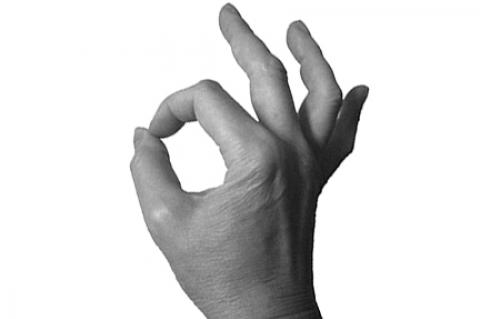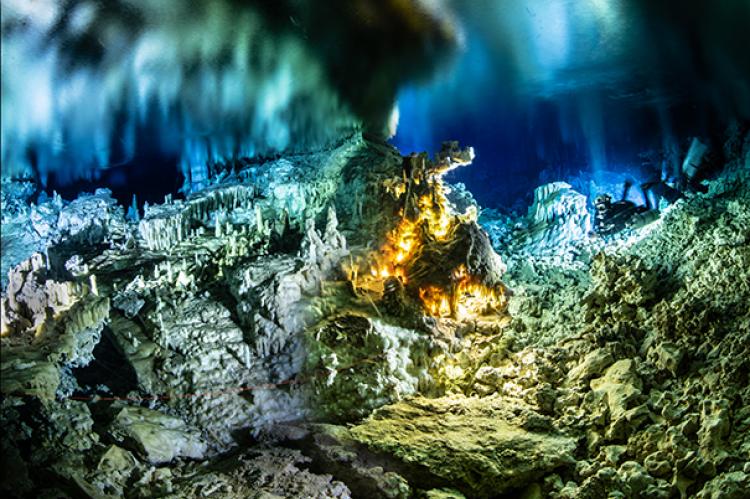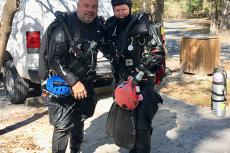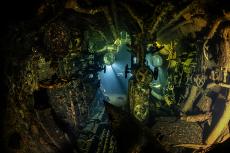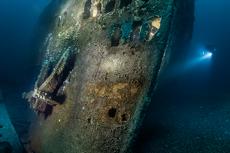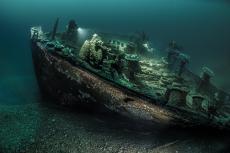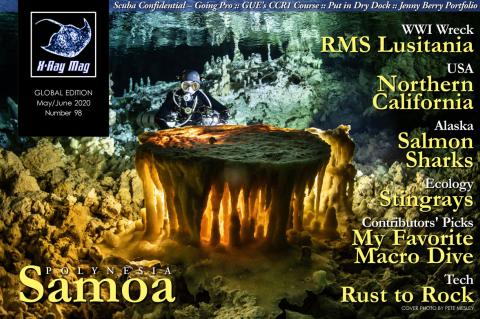From Rust to Rock
For years and years, people have often asked me, “Hey, why aren’t you a cave diver?” And I would respond simply, “When I have dived all the wrecks of the world (twice), I will then think about diving Wet Rocks!”
Exquisite formations found in the cave system on Muna Island in Southeast Sulawesi, Indonesia, during the cave exploration expedition. Photo by Pete Mesley.
Tags & Taxonomy
I learnt to dive in 1989, doing my initial training dives in the quarry at Stony Cove in England, a popular inland dive location about 125 miles north of London. I remember, to this day, doing my first training dives. It was January, in mid-winter. The water temperature was 4°C (that’s the recommended temperature for drinking Heineken) and I was in a wetsuit!
When we finally got off the deck and had a swim around, we were guided around some structures, which were sunk in the lake for us to look at. A plane fuselage, bus, VW combi-van and a small boat were conveniently placed around for us to stumble over in the dark abyss. I remember swimming into the fuselage of the plane and becoming instantly hooked. From that second onwards, every waking hour of the day, I was thinking about wrecks, researching and diving them. This was when my “Lust4Rust” was born.
Wreck diving passion
We formed a small group of mad keen diving fanatics, and we would meet every Thursday evening at the local pub in London without fail. Here, we would plot and scheme what wrecks we would be diving on the weekend.
I loved every second of it: getting up at 4:00 a.m. in the morning to drive down to the coast; eating “bacon butties” before we got onto the dive boat; shortly thereafter, losing all stomach contents to the ocean as soon as we left the harbour; battling through questionable seas, shotting the wreck; getting geared up; jumping in; doing a 30-minute bottom time; doing safety/deco stops, holding onto the shot line in the current like a granny in a gale force wind; getting picked up by the boat (which stank of diesel and dead fish—more stomach contents lost!) and navigating the fishbone ladder in a 3m swell. To the untrained ear, this does not sound inviting at all, but we all loved it and lived for it. This was the beginning of what would be 29 years of wreck exploration (and counting).
Looking at it now, if I did my open water course in Florida and all my mates were mad keen, passionate cave divers, and all the talk I heard was about caves, would I still be mad keen into wrecks? Or would I acquire an equal passion for cave diving?
First steps into cave diving
For decades, the thought of cave diving never entered my mind. I had no interest in it what-so-ever. It was not until about five years ago, when I was looking at images of the flooded mines off Bell Island, Newfoundland, that I really wanted to get into those mines myself and take some pictures of my own. It was this that really prompted me to take the steps to get full cave training, as this was a prerequisite for the trip. So, begrudgingly, I set out to do my course.
So, who would I get to do my course? Who better than world-renowned explorer, diving pioneer and good mate—Jill Heinerth? I contacted Jill, and we were on!
Some months later, I found myself in Florida. Wanting to fully immerse myself, I rented out an RV in the middle of cave country, bought a banjo, sat on a wooden rocking chair and attempted to play that song from Deliverance. Just kidding! (About the last two bits.)
We started our training at Ginnie Springs, and one of the first things Jill said to me was, “How far do you want to go in your training?” And (stupidly) I replied, “Just push me as far as possible until I let out a whimper,” or “as far as you think I am capable of.”
Well, that was some of the best training I have received in the last 10 years collectively! It was great. Lost-line drills, no-mask and loss-of-light drills. Swimming blind for hundreds and hundreds of metres, deep inside the cave. Learning the art of touch communication, entanglement protocol, line work and extensive dive planning were just some of the skills that were honed on the course. I also learnt (the hard way) what “Ginnie Fingers” meant and also learnt to swim against very powerful water flows, figuring out how to read the flow by observing rock outcrops.
Not only was I pushed to the limit, but I also learnt the spiritual side of cave diving too. Jill’s insight into how the caves were formed, water flow and all the hidden aspects of respecting the environment really opened my eyes to a whole new world. Was I warming to the fact that cave diving was not as bad as initially thought?
I even resurrected my blue helmet (which I thought was pretty cool 16 years ago while open ocean diving). Since then, it has been on the shelf… until now! It has saved my head on more than a few occasions, squeezing into tight areas.
Do wreck divers think the same as cave divers?
There are many similarities that wreck divers share with cave divers. The sense of exploration, working as a team and precise planning are a few of these shared traits. It was also interesting to learn all about the cave, how it was formed, outcrops, how mud on the bottom had not been disturbed for thousands upon thousands of years.
I also learnt a strong sense of pride, ownership and preservation from Jill about every cave we dived. These views are shared with fellow wreck divers, who yearn for knowledge about the history of a wreck, how it was sunk, what its cargo was, etc. Over the years, I have also learnt about preservation of our precious resources. It was not always that way.
When I cut my teeth on wreck diving back in 1989 in the United Kingdom, it was all about “spidge” (artefact recovery) and BRASS! That was the predominant pastime—getting as much brass as you could. Something I have learnt over the years is that 99 percent of all the brass recovered off wrecks, portholes, binnacles, etc—ends up rotting away in someone’s garage or lying in the long grass in-between the garage and the boundary fence!
Of course, I do not partake in that anymore. In fact, that is how I got into photography, because I was absolutely rubbish at collecting artefacts and could not see the point. I just focused on taking pictures from then onwards.
Cave photography
It was really interesting for me to dive with some cave divers while I was in Florida after my course. The first thing I wanted to do was get back to Peacock Springs and take some pictures of some of the fantastic rooms I visited. I was lucky enough to dive with a local prominent GUE cave instructor. I warned her that I probably would not go that far and would spend quite a while in one place.
Sure enough, we got about 200m into the cave. I saw the frame I wanted and proceeded to carefully place lights. After about 90 minutes of set up, long exposures and light painting, we ended the dive. I apologised about taking so long and thanked my buddy for her patience. One of the things she said to me was really interesting. She said that she had been through there hundreds of times but never “saw” the cave in that light before.
This was also an observation I made while diving with a group of cave divers in that same timeframe. For the first dive, we planned to go to a place called the “Dome Room.” We planned it, discussed procedures, how many jumps we would do, etc. All good. Off we went.
As we were heading to our objective, swimming against the flow, we came into many spectacular rooms. I had two large (15K) floodlights and lit up these large areas. We did not stop to enjoy these amazing views. Instead, we pushed on. I guessed we would have time on the way back to appreciate these outcrops and topography.
As we got to the Dome Room, we kind of “touched the back wall,” and then the sign was given to head back. OK, maybe we would stop on the way back to check out these rooms. Nope! On completion of the dive, the guys said how amazing the dive was. I made a comment, asking how come we did not stop in these rooms to enjoy them. “We were heading for the Dome Room,” was the answer. What about the bits in-between?
On the next dive, the guys wanted to go farther into the cave, with more complex jumps. I declined. It seemed to me that the main objective (of this group) was just in the planning of the dive and how well the jumps were executed. The visual features of the cave were not really discussed at all. This was really odd for me. But, on reflection, thinking more about it, the same could be said about wreck divers solely focused on artefact recovery—or photography, for that matter.
Single-minded
I went to Malin Head, County Donegal, Ireland in 2017. I was diving with a mate of mine, Barry McGill, who was extremely knowledgeable on the area and had been running trips there for years. I had been wanting to dive these wrecks for decades. When I finally got to go, I had one picture in mind for each wreck. With this in mind, I spent an entire dive getting that “one money shot.”
Now, logic would dictate that one should have a good look round the wreck and get a good idea of the ship first. But what I ended up doing was focusing on one area. On reflection as to why I chose to do that, it was simple. For me, my personal objectives and outcomes for that trip were straightforward. I really just wanted to get a few images, which depicted the essence of the wreck. In my experience, this takes time, effort and focus.
One particular dive was on the SS Justicia—a 32,000-ton, 237m-long ocean liner converted to a troop carrier in the First World War, which was sunk after being hit no less than six times by torpedoes. She now sits in 68m of water. I focused on the bow section, spending the whole 40 minutes on the bottom to get two shots! But for me, personally, this was totally worth the dive. So, are we wreck divers really that different from cave divers?
Could the tides be changing?
Recently this year, in February, I was very fortunate to be part of a small team of cave explorers. We went to the Southeast Sulawesi province in Indonesia. The objectives of the expedition were to seek out new virgin caves, explore them, and map, document and photograph them. I had never been a part of this kind of cave exploration before, and I was excited about the concept. I did not take my camera on these initial dives. Instead, I mounted a small point-and-shoot camera on my helmet (which ended up being a dumb idea on open circuit).
I have to admit, when I got my head around the fact that we were exploring, I became a ferret, poking into holes, looking for any passageways. Although I was still scoping out possible future picture opportunities, my mindset was completely different than when I had a camera in my hand.
It was fun—lots of fun. We came up with a lot of dead ends, got stuck quite a few times and laid a lot of line. Great times. But taking images of these places brought the biggest joy to me. I “get it” now, about caves.
Some lasting thoughts
I think our interests are widely influenced by our geographical surroundings and the people around us. One thing is for sure, it does not really matter much what you pursue. If you surround yourself with like-minded people and positive role models, you can feed your passion—whatever it is, wherever it is. Be open to trying new things. You might surprise yourself… I did!
So, seeing both ends of the spectrum, I am really privileged to have the opportunity to experience different worlds, and also to have positive role models in my life. Everyone has their own objectives in their activities. The key is to match these objectives with the people with whom you dive.
I have been actively exploring shipwrecks for the last three decades, and it is a very addictive thing. Having that urge to learn new things too, is equally addictive. I am still a “Rust Guy” through-and-through, but I am looking forward to planning new cave adventures and spending time with friends; to finally get to Newfoundland and dive those flooded mines, which started me on this mad journey; to learn new things. I can’t wait.
We might all be suffering from current global adversities, BUT the future is looking very exciting. ■
Based in New Zealand, Pete Mesley, owner and sole operator of Lust4Rust Diving Excursions, runs specialised trips to some of the world’s best wreck diving destinations. He runs a tight ship and is totally dedicated to safety by bringing an experienced hyperbaric physician with an emergency medical kit on all his trips. For more information on Lust4Rust Diving Excursions trip schedules, please visit: lust4rust.co.
Download the full article ⬇︎
